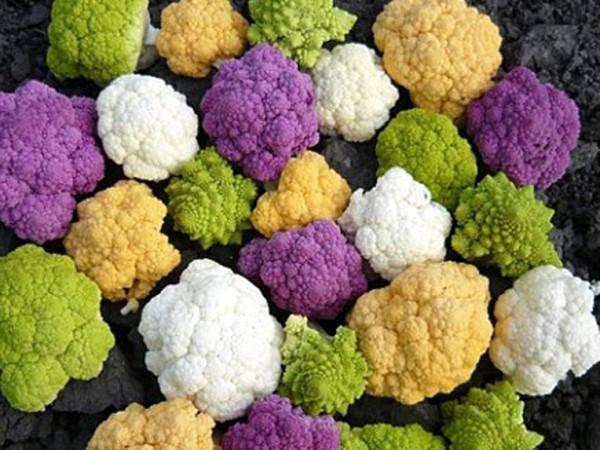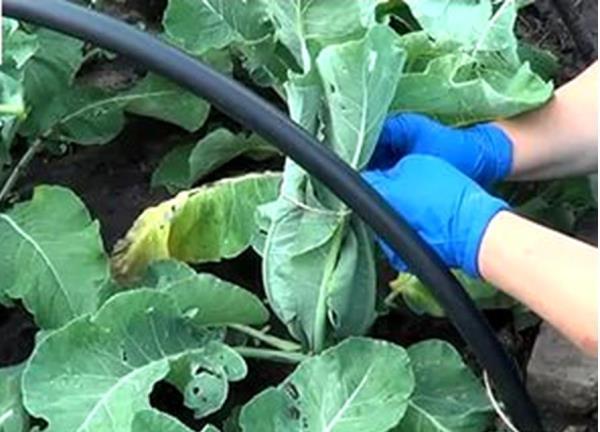Grow, cauliflower, huge, huge
The cauliflower brought to Russia from the Mediterranean has come to the taste of gardeners. And not only in the literal sense, since its inflorescences are pickled, and baked, and all kinds of salads are made, and soups, borscht are cooked from it, garnishes are prepared and even cutlets and pies are made.

Lovers of tinkering in the ground liked this plant and for the unpretentiousness of this plant, which does not require extremely great care. But, as in every case, here too there are tricks, knowing which you can achieve the most effective result.
Read also the article in the topic: how much to cook cauliflower?
Temperature control is an important component of success
This plant, although it comes from a warm climatic zone, does not really like warmth. If the cabbage grows in the heat above 25 degrees, then it is quite possible that it will upset the gardener with its small and loose heads. This is especially noticeable with insufficient watering.
But it also reacts sensitively to low temperatures. If white cabbage easily tolerates even small frosts, then for cauliflower they are destructive. And even with a cold snap below 15 degrees, one should not hope to get large heads, especially with prolonged exposure to low temperatures.

The most bountiful harvest of this crop happens if it is constantly in comfortable conditions for it.
And it's worth remembering that cauliflower grows and ripens best at 15-20 degrees Celsius.
Does cabbage need sunlight or not?
It is impossible to answer this question unequivocally. Here it is worth dividing the period of the life of the culture:
- the emergence of seedlings before the formation of inflorescences;
- formation of heads.
Cauliflower seeds are sown in open ground in June, especially early ripening varieties. At this time, small shoots need warmth, moisture and a lot of sunlight. However, after the plant has 25-30 leaves, it begins to form an inflorescence. Here you need to take care that no light falls on it, artificially shorten the day.

In order for the cauliflower heads to be large and strong, rather than loose and shapeless, experienced experts advise covering the heads with lower cabbage leaves. This procedure is not so difficult as painstaking. The lower leaves of the plant are lifted up and held together to shade the inflorescence. Sometimes they are broken out and placed on the head. But then there is a possibility that they could be blown away by the wind.

If cauliflower inflorescences are left in their natural environment with a long daylight hours, they will form flowering shoots, the head of cabbage will be loose and shapeless.
Soil composition
As you know, the roots of cauliflower are not as powerful as those of white cabbage. Therefore, it is difficult for a plant to extract useful trace elements from the depths of the soil. What should a gardener do to get a high yield of this crop?

First, you should know that you need to sow seeds in those places where they grew before:
- non-cruciferous roots (potatoes, beets, carrots, onions);
- legumes (peas, beans, beans);
- melons (cucumbers, zucchini, watermelons, pumpkins, melons).
In no case should you plant cabbage in places where cruciferous plants (radishes, turnips, radishes, cabbage) were grown last year, as well as winter sowing of root crops was carried out.

The land must be prepared in advance, even in the fall.For a better harvest, after applying manure or peat compost (8 kilograms per square meter) to the soil, the territory is dug up. In spring, mineral fertilizers are additionally introduced into the soil at the rate of 1 square meter:
- superphosphate - 50 g;
- ammonium nitrate - 30 g;
- potassium chloride - 20 g.
They dig up the earth again, loosen it thoroughly.
Cauliflower dressing
But even the soil properly processed before planting is not one hundred percent success. What should be done additionally to make the cauliflower look great? The answer is simple: you should regularly feed the plants. And in addition to the main fertilizers used for growing cabbage, this crop is fed with boron and magnesium, manganese and molybdenum. With an insufficient content of these microelements in the soil, the heads develop poorly, the stalks of the plant become hollow, the leaves become deformed. Often, head rotting occurs at all.

You need to start feeding the seedlings after three real leaves have formed on them. At this time, cabbage is very necessary during watering a solution of ammonium or potassium nitrate. For its preparation, it is enough to dilute 5 grams of ammonium or 15 grams of potassium nitrate in a bucket of water.

With the appearance of the next leaf, the plant is sprayed with a special solution. They take molybdenum-sour ammonium and boric acid, 2 grams per 10 liters of water - this is the best composition of foliar feeding during this period of cauliflower growth.

It is not necessary to water the seedlings very often, only so that the earth does not dry out, but do it intensively.
Briefly about the main
Deciding to grow cauliflower on your site, you need:
- start preparing the soil in the fall;
- apply mineral fertilizers before the spring digging of the earth;
- regularly feed plants (root and spraying);
- watering the culture not often, but abundantly;
- cover inflorescences from light.

How to shade cauliflower inflorescences?
Following these rules, even a novice gardener will achieve a good harvest, such that the fruits of cauliflower can be proudly called not “heads”, but “heads” or even “heads”!